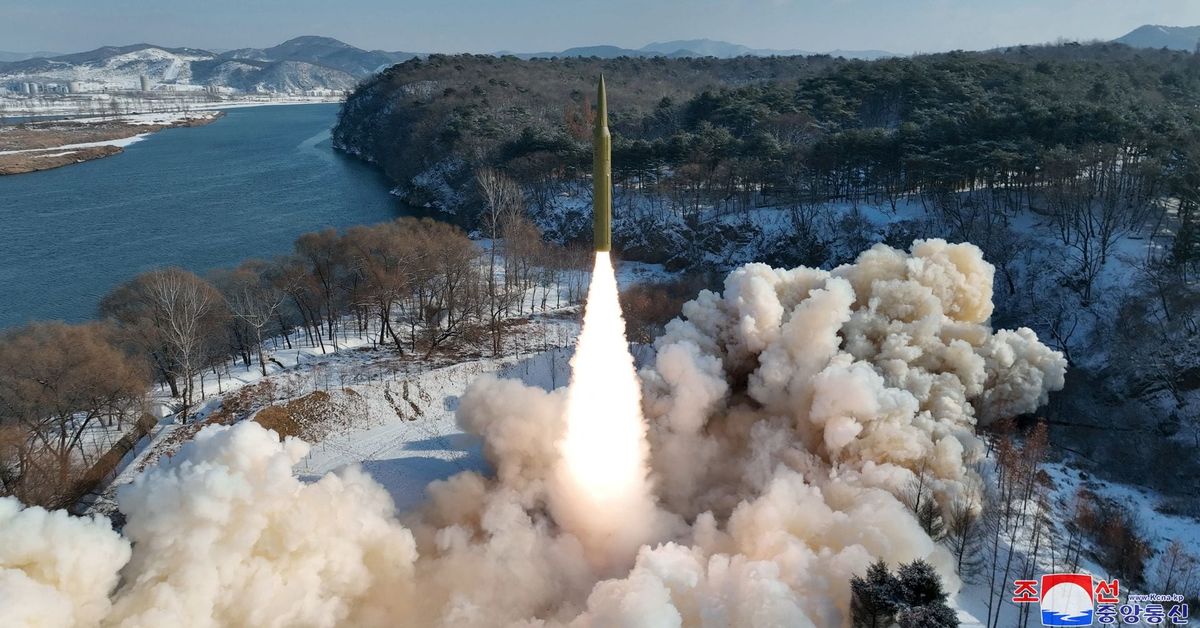Following Iran’s recent claims of advancements in hypersonic weapon development, North Korea now asserts its progress in this field. According to state media reports, the country successfully launched a new solid-fuel “hypersonic” missile on January 14, marking a significant achievement in its weapons program.
The intermediate-range ballistic missile was launched from a site near Pyongyang, following a lofted trajectory for less than 12 minutes. According to the South Korean and Japanese militaries, it subsequently landed in the waters between North Korea and Japan.
This launch represents the convergence of two recent milestones for Pyongyang’s weapons development program — solid-fuel missiles and missiles featuring a “maneuvering re-entry vehicle.”
While North Korea has previously claimed separate successful tests of solid-fuel and maneuverable missiles, this launch integrates both technologies.
Solid-fuel missiles possess the advantage of being fueled clandestinely before deployment, reducing the time available for adversaries to launch preventive strikes.

On the other hand, maneuverable missiles, often hypersonic missiles, can alter their trajectories mid-flight using fins or winglets, which can enhance accuracy and make interception by defense systems more challenging.
North Korea had not publicly disclosed information about its “hypersonic” missile development since conducting tests in September 2021 and January 2022.
However, a July military parade and weapons expo showcased the liquid-fuel Hwasong-12B IRBM with a hypersonic glide vehicle (HGV).
The report accompanying the announcement includes a single photo, suggesting the presence of a “maneuverable reentry vehicle (MaRV),” according to Ankit Panda, a Stanton Senior Fellow in the Nuclear Policy Program at the Carnegie Endowment for International Peace.
Panda notes that the missile likely executed terminal-stage maneuvers, which indicate Pyongyang’s pursuit of systems with enhanced precision and the ability to penetrate missile defenses more effectively.
A Race To Deploy Hypersonic Systems
The global landscape of military capabilities has witnessed a dramatic transformation in recent years as large and small nations engage in a spirited race to develop hypersonic weapons.
This surge is part of an overarching arms race, with smaller nations endeavoring to match the advanced long-range missiles wielded by major military powers.
Hypersonic weapons and Fractional Orbital Bombardment Systems (FOBS) are at the forefront of this technological race, both raising concerns due to their potential to evade conventional missile shields and early warning systems.
North Korea is actively working on developing hypersonic and intermediate-range ballistic missiles using solid propellant rocket boosters.
Iran, too, has made advancements, unveiling its hypersonic missile last year and positioning itself among a select group of nations, including China and Russia, capable of deploying long-distance weapons with exceptional maneuverability.
The spotlight on hypersonic development intensified when China launched a rocket with a hypersonic glide vehicle in 2021, circling the globe before narrowly missing its intended target.
In the same year, Russia, in a display of technological prowess, successfully tested the Tsirkon (Zircon) hypersonic cruise missile, and President Vladimir Putin emphasized its significance in modernizing missile systems.
Russia has even deployed its hypersonic missiles in the ongoing conflict with Ukraine. Yet, despite worries about Moscow’s hypersonic capabilities, especially in Europe, the Pentagon suggests that Russia’s technology is not as sophisticated as China’s.
While nations such as Russia, China, Iran, and North Korea—characterized as adversarial states by the US—are advancing in this field, the United States and the European countries are encountering challenges in the development of similar weapons.
Despite over six decades of investment totaling billions of dollars, the United States has faced numerous setbacks in developing its hypersonic technology.
The Pentagon grapples with challenges ranging from failed flight tests to inadequate testing infrastructure and the absence of a comprehensive plan.
The implications of this global pursuit of hypersonic weapons are profound. Hypersonic weapons, particularly in the hands of nations like China or Russia, have the potential to disrupt the longstanding strategic balance of US defense policy.
While the US military remains a formidable force, the advent of hypersonic missiles introduces a new dynamic, allowing adversaries to challenge its superiority by evading early warning systems and strategically targeting critical assets such as naval fleets and overseas bases.
A hypersonic attack could potentially render even the most advanced US warship defenseless. However, in recent years, the US has undertaken various projects with partner nations to advance hypersonic and counter-hypersonic systems.
- Contact the author at ashishmichel(at)gmail.com
- Follow EurAsian Times on Google News